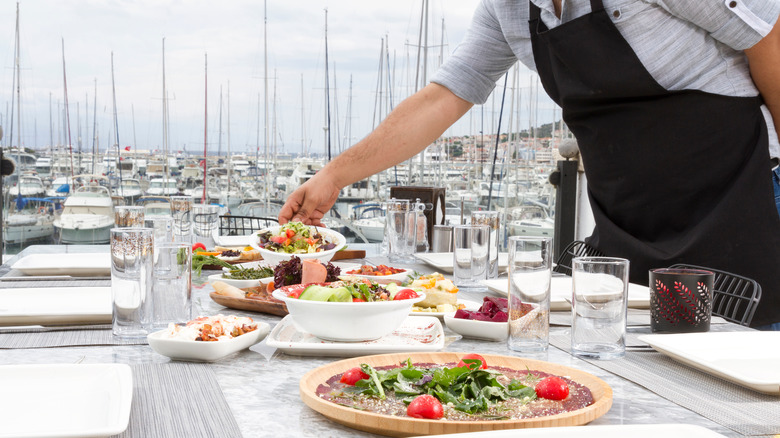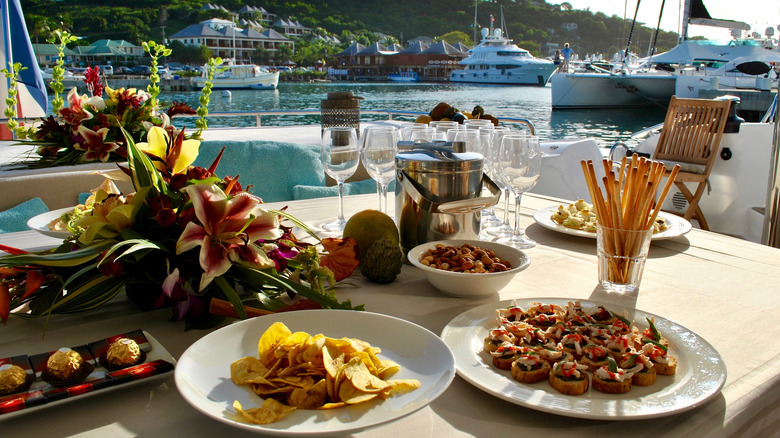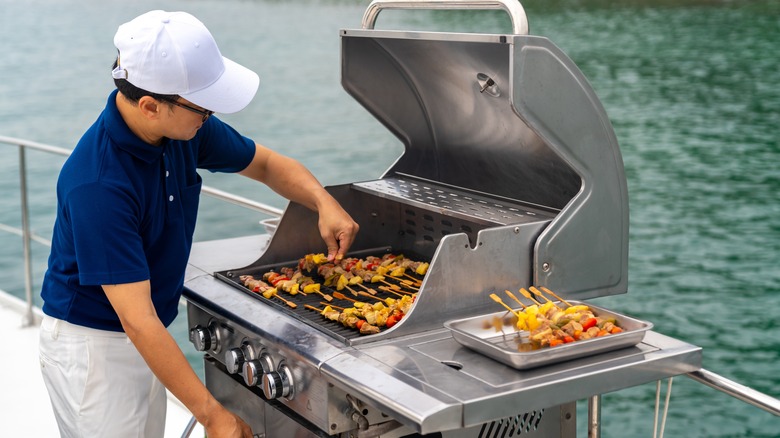The Stunning Amount Of Hours Yacht Chefs Work (But The Tips Might Be Worth It)
A chef job on land is demanding enough — 12-to-14-hour days with night, weekend, and holiday shifts can add up to more than 90 hours a week. The median pay for a chef in 2021 was just over $50,000 per year. But what about being a private chef — specifically, on a private yacht?
According to yacht chef Nina Wilson, a typical day in the life looks something like this: between 6 a.m. and 2 p.m., you're prepping the day's bread, breakfast, lunch, and dessert (and serving breakfast and lunch, of course). After a two-hour break, the chef works on appetizer, dinner, and dessert prep until 8 p.m., followed by dinner service. By 11 p.m., you're wrapping up cleaning, prepping a menu for the next day, defrosting meat, feeding dough starters, and the like. And, of course, you remain on call for guests' late-night munchies. That's a 16-hour day, even without a 2 a.m. call for snacks. All in all, it's normal for a yacht chef to work more than 110 hours a week.
Yacht chefs get paid well for the effort, with Dock Walk reporting a salary range of $5,500-$12,000 per month before tips. And while tips are usually 5-15% of the weekly charter cost split amongst the crew, yacht chef Rachel Cunningham told Food & Wine that a friend once made nearly $40,000 in tips from one charter alone.
Meal planning for cooking at sea
There are two significant differences between your typical kitchen job and being a yacht chef: you're changing the menu every meal and generally have an unlimited budget for guests. Guests are spending extraordinary amounts of money onboard a chartered yacht and want to eat very well. Creativity is a must, and you generally have a lot more freedom than in a restaurant. This can be a blessing and a curse; because it's not a business where you're focused on profit margins, your imagination can run wild. But at the same time, unless you're specifically asked to by the guests, you will have to cook something different for every meal. Between breakfasts, lunches, appetizers, dinners, and desserts, for a three-week charter, that's up to 105 meals.
If you're on a boat, ingredient management is critical: there's no emergency trip to the store when you run out of almond flour. Long passages mean stocking up for the entire journey, and remote ports can make it hard to replenish staples. Not only is estimating and moderating usage essential, but storage is, too; yachts are pretty stable due to their size, but rough seas happen. Prepping for service in a storm looks slightly different on a boat than in a restaurant kitchen if you don't want to sweep your ingredients off the galley floor just to prep them all again and run out of them before your next port.
An excellent job for entrepreneurial DIYers
According to Nina Wilson, the number of kitchen crew you have generally depends on the size of the vessel. On a 24-to-55-meter ship, you'll be a one-chef show. On a 55-to-80-meter boat, you'll have a sous chef, and once you get over 80 meters, you'll add a crew chef or two to the mix. On a two-chef team, you're probably working with 12 guests and maybe some extra dinner guests here and there. As the head chef, you'll be doing all the cooking for the guests. As the sous chef, you feed the crew and support the head chef with any extra tasks they have for you, but the head chef will support the sous during crew service.
Here, you're doing most work yourself with a bit of help. And because of the confined space on board and infrequent restocks, you're making nearly everything from scratch: bread, desserts, sauces, and stocks. On top of that, you're meal planning, meal prepping, cleaning, tracking receipts and invoicing, and sourcing ingredients at the port. It's a lot of work, and a lot of yacht chefs burn out, says Rachel Cunningham. But the money is decent, and you get paid to travel the world — even if sometimes you're looking at it through a round galley window.


